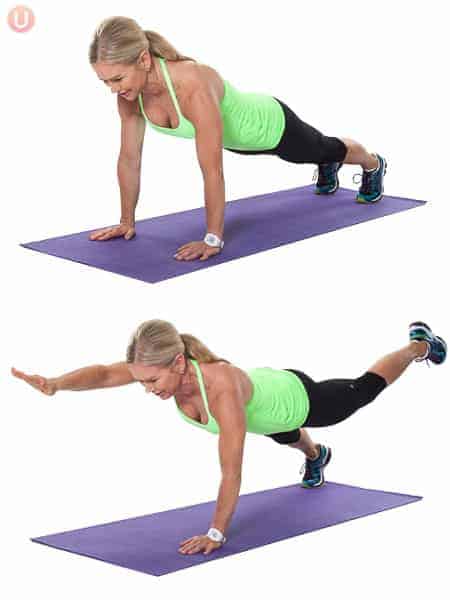Yoga is about constant repetition. Although this may sound boring, there are many asanas in a yoga practice that you do every time you’re on the mat. Plank pose is one of them.
Traditional plank pose is put as part of sequences such as Surya Namaskar. But we’d like to discuss today the idea of using Plank pose as a separate exercise. So knowing all of its modifications helps you add variety to your yoga routine.
We have included the basics of the Plank pose and Side plank pose in our previous posts.
So let’s skip the theory and get right to the practice.
Tree Leg Plank Pose
Advanced yogi option. Before you practice it, you should be able to perform Side plank for at least 3 minutes on each side.
To get into the Tree legs plank pose, start in the traditional Plank pose on all fours.
With the inhale, turn to the Side plank, for example, to the right side first. This means the outer side of your left leg is pressed to the floor; your right foot is on top of the left one, the right arm is reaching up to the ceiling.
Bend your right leg and put the right sole on the left leg. Easy ¬– sole touches the inner part of the ankle, more challenging – sole to the inner thigh. Avoid arching your back. Don’t lower your pelvis and try to press through to the left leg and left arm. Engage your core.

Return to the traditional Plank pose and repeat on the other side.
Balancing Plank Pose
For intermediate yogis. If you want to challenge your balancing skills, there is a variation of Plank pose for it.
Begin from the Tabletop position with your palms under your shoulders and knees under your hip bones.
- Stretch your left leg and put the left toe on the mat.
- Shift your body weight to the right. Press through the right palm and right knee.
- Next, as you inhale, start to turn your core to the left and open your left hip. Reach your left hand up to the ceiling.
- Watch out for the balance. If you sway while looking up, turn your gaze down into the middle of the right hand.
- Remember to take deep and smooth breaths in and out.
Plank Pose with Leg Lifts
For beginners and intermediate yogis. When you feel strong and stable enough in a traditional Plank pose, proceed to leg lifts. They are pretty simple to achieve.
Start in a basic Plank pose and, then, lift one leg and hold the position for 3-5 breathe cycles. Do for both legs and increase the duration gradually.

The same can be done in Side and Forerm plank positions.
To activate lateral fascia lines, lift one leg and one hand at a time and hold the position for several breath cycles.

Plank Pose Dynamic Sequences
For advanced yogis. Instead of being bored holding a static version of the Plank pose, you can have fun and add motion to it.
Side Plank Pose (Vasisthasana)
For example, when in Plank pose, lift right leg and left arm above the floor. Next, bend elbow and knee on the lifted extremities and try to touch your elbow with your knee.
This variation will challenge your back and core muscles. Stick to your breath pace and inhale as you lift leg and hand and exhale as you reach elbow with your knee.
Find below a whole sequence created of several Plank pose variations and transitions between them:
